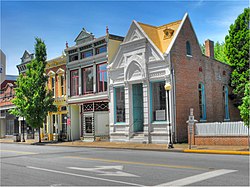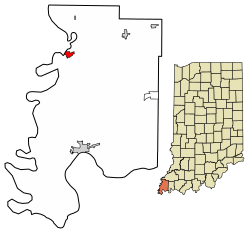New Harmony, IN
| New Harmony, Indiana | |
|---|---|
| Town | |
 |
|
 Location of New Harmony in Posey County, Indiana. |
|
| Coordinates: 38°7′43″N 87°56′3″W / 38.12861°N 87.93417°WCoordinates: 38°7′43″N 87°56′3″W / 38.12861°N 87.93417°W | |
| Country | United States |
| State | Indiana |
| County | Posey |
| Township | Harmony |
| Area | |
| • Total | 0.76 sq mi (1.98 km2) |
| • Land | 0.75 sq mi (1.95 km2) |
| • Water | 0.01 sq mi (0.02 km2) |
| Elevation | 381 ft (116 m) |
| Population (2010) | |
| • Total | 789 |
| • Estimate (2016) | 763 |
| • Density | 1,011.94/sq mi (390.55/km2) |
| Time zone | CST (UTC-6) |
| • Summer (DST) | CDT (UTC-5) |
| ZIP code | 47631 |
| Area code(s) | 812 |
| FIPS code | 18-52974 |
| GNIS feature ID | 440051 |
| Website | http://www.newharmony-in.gov |
New Harmony is a historic town on the Wabash River in Harmony Township, Posey County, Indiana. It lies 15 miles (24 km) north of Mount Vernon, the county seat, and is part of the Evansville metropolitan area. The town's population was 789 at the 2010 census.
Established by the Harmony Society in 1814 under the leadership of George Rapp, the town was originally known as Harmony (also called Harmonie, or New Harmony). In its early years the 20,000-acre (8,100 ha) settlement was the home of Lutherans who had separated from the official church in the Duchy of Württemberg and immigrated to the United States. The Harmonists built a new town in the wilderness, but in 1824 they decided to sell their property and return to Pennsylvania.Robert Owen, a Welsh industrialist and social reformer, purchased the town in 1825 with the intention of creating a new utopian community and renamed it New Harmony. While the Owenite social experiment was an economic failure two years after it began, the community made some important contributions to American society.
New Harmony became known as a center for advances in education and scientific research. Town residents established the first free library, a civic drama club, and a public school system open to men and women. Its prominent citizens included Owen's sons: Robert Dale Owen, an Indiana congressman and social reformer who sponsored legislation to create the Smithsonian Institution; David Dale Owen, a noted state and federal geologist; William Owen, a New Harmony businessman; and Richard Owen, Indiana state geologist, Indiana University professor, and first president of Purdue University. The town also served as the second headquarters of the U.S. Geological Survey. Numerous scientists and educators contributed to New Harmony’s intellectual community, including William Maclure, Marie Louise Duclos Fretageot, Thomas Say, Charles-Alexandre Lesueur, Joseph Neef, Frances Wright, and others.
...
Wikipedia
